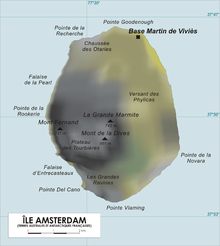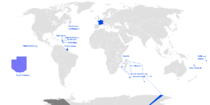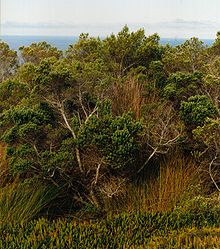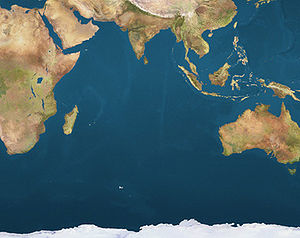- Île Amsterdam
-
Not to be confused with the Amsterdam Island in the Svalbard archipelago, near Spitsbergen; see Amsterdamøya.
New Amsterdam Île Amsterdam
Motto: Liberté, égalité, fraternité Anthem: La Marseillaise Orthographic projection centred over île AmsterdamÎle Amsterdam Nickname: Nouvelle Amsterdam
Phylica arborea grove on Île Amsterdam.
Map of Île Amsterdam.Geography Coordinates 37°49′33″S 77°33′17″E / 37.82583°S 77.55472°E Area 55 km2 (21.2 sq mi) Length 10 km (6 mi) Highest elevation 867 m (2,844 ft) Highest point Mont de la Dives Country Demographics Population Uninhabited New Amsterdam, Amsterdam Island, or (French) Île Amsterdam (French pronunciation: [ilamstəʁˈdam]; named after Amsterdam, the Dutch capital; also called (French) Nouvelle Amsterdam) is a French island in the Indian Ocean located at 37°49′33″S 77°33′17″E / 37.82583°S 77.55472°ECoordinates: 37°49′33″S 77°33′17″E / 37.82583°S 77.55472°E. It is part of the French Southern and Antarctic Lands.
Contents
History
This island was discovered by the Basque explorer Juan Sebastián Elcano on March 18, 1522, along his first world circumnavigation. Elcano did not name the island, however.
Having found the island unnamed, the Dutch captain Anthonie van Diemen named it Nieuw Amsterdam (Dutch for New Amsterdam) after his ship in 1633.
French Captain Pierre François Péron (not to be confused with François Péron) was marooned three years on this island (from 1792 to 1795). Peron's Memoires, in which he describes his survival alone on New Amsterdam, were published in a limited edition and are now an expensive collectors' item.[1][2][3]
In January 1871 an attempt to settle the island was made by a party led by Heurtin, a French resident of Reunion Island. After seven months there, their attempts to raise cattle and grow crops were unfruitful and they returned to Reunion, abandoning the cattle on the island.[4]
The islands of Île Amsterdam and Île Saint-Paul were attached to Madagascar in 1924 and hence became a French colony.
However, Amsterdam island, along with Saint-Paul island, is considered by some Mauritian parties as a national territory. The question of Mauritian sovereignty over these two islands was raised in 2007 by the leader of the opposition, Paul Raymond Berenger. This new claim could be raised in discussions with France, along with a claim to Tromelin Island which has been officially maintained for a long time.[5]
The first French base in New Amsterdam was erected in 1949, and was originally called Camp Heurtin. The Global Atmosphere Watch still has a research station on Île Amsterdam.
Geography
The volcanic island is a potentially active volcano which last erupted in 1792. It has an area of 55 km2 (21 sq mi), measuring about 10 km (6.2 mi) on its longest side, and reaches as high as 867 m (2,844 ft) at the Mont de la Dives. The high central area of the island, at an altude of over 500 m, containing its peaks and caldera, is known as the Plateau des Tourbières (in English the Plateau of Bogs).
The island is a part of the French Southern and Antarctic Lands (Terres australes et antarctiques françaises; TAAF), and together with neighboring Île Saint-Paul (85 km/53 mi to the South) forms one of the five districts of the territory. Its base, Martin-de-Viviès, formerly called La Roche Godon, is the capital of the territory.
Île Amsterdam is one of only three land antipodes of the continental United States. It corresponds to an area about 20 miles (32 km) southeast of Lamar, Colorado. (The other two land antipodes of the U.S. are île Saint-Paul and Kerguelen Island.)
The only human habitation is at the Martin-de-Viviès base with about 30 inhabitants related to the study of fauna, weather, the atmosphere and geomagnetism.
Climate
Île Amsterdam has a mild, oceanic climate, with a mean annual temperature of 13 °C (55.4 °F), rainfall of 1,100 mm (43.3 in), persistent westerly winds and high levels of humidity.[6]
Fauna and flora
Further information: Amsterdam and Saint-Paul Islands temperate grasslandsThe island has Phylica arborea trees, which are also found on Tristan da Cunha and Gough Island.
Wildlife
Birds
The island is home to the endemic Amsterdam Albatross, which breeds only on the Plateau des Tourbières. Other rare species are the Great Skua, Antarctic Tern and Western Rockhopper Penguin. The Amsterdam Duck is now extinct, as are the local breeding populations of several petrels.[7] The Common Waxbill has been introduced.[8]
Mammals
There are no native land mammals. Subantarctic fur seals and southern elephant seals breed on the island. Introduced mammals include the house mouse and brown rat. Feral cats are present.[8]
A distinct breed of wild cattle also inhabits the island. They originate from the introduction of five animals by Heurtin after his brief attempt at settlement of the island in 1871,[8] and by 1988 had increased to an estimated 2,000. Following recognition that the cattle were damaging the island ecosystems, a fence was built restricting them to only part of the island.[7]
See also
- List of volcanoes in French Southern and Antarctic Lands
- French overseas departments and territories
- Administrative divisions of France
- Islands controlled by France in the Indian and Pacific oceans
References
- ^ Statewide County HI Archives: News, USGenWeb Archives
- ^ Forum Rare Books: In the news, Antiquariaat Forum
- ^ Mémoires du capitaine Péron sur ses voyages, Google Books
- ^ Carroll, Paul (2003-06-29). "Amsterdam/St Paul: Discovery and early history". The South Atlantic and Subantarctic Islands. http://www.btinternet.com/~sa_sa/amsterdam/amsterdam_history_early.html. Retrieved 2011-04-25.
- ^ Debate No. 31 of 06.11.2007 Oral answers to questions : Chagos archipelago and Tromelin Islands Mauritian sovereignty
- ^ [1]
- ^ a b Micol, T.; & Jouventin, P. (1995). Restoration of Amsterdam Island, South Indian Ocean, following control of feral cattle. Biological Conservation 73(3): 199-206.[2]
- ^ a b c Amsterdam Island - Introduced fauna
Further reading
- Pierre François Péron, Mémoires du Capitaine Péron, sur ses Voyages aux Côtes d’Afrique, en Arabie, a l’Île d’Amsterdam, aux Îles d’Anjouan et de Mayotte, aux Côtes Nord-Oeust de l’Amérique, aux Îles Sandwich, a la Chine, etc., Paris 1824
- Alfred van Cleef, The lost island. Alone among the fruitful and multiplying, Metropolitan, New York 2004 (ISBN 978-0-8050-7225-9)
External links
- photos of Ile Amsterdam and St.Paul (French site)
- Ile Amsterdam visit (photos from a tourist's recent visit)
- French Colonies—Saint-Paul & Amsterdam Islands, Discover France
- French Southern and Antarctic Lands at the CIA World Factbook
- South Atlantic & Subantarctic Islands site, Amsterdam Island page
 Overseas departments and territories of France
Overseas departments and territories of FranceInhabited areas  Special status
Special statusUninhabited areas Pacific Ocean French Southern and
Antarctic LandsBanc du Geyser4 · Bassas da India4 · Europa Island4 · Glorioso Islands3, 4, 5 · Juan de Nova Island4 · Tromelin Island4, 51 Also known as overseas regions. 2 Claimed by Comoros. 3 Claimed by Madagascar. 4 Claimed by Seychelles. 5 Claimed by Mauritius.Outlying territories of European countries Territories under European sovereignty but closer to or on continents other than Europe (see inclusion criteria for further information)Denmark France Italy Netherlands Norway Portugal Spain United
KingdomAnguilla · Bermuda · British Virgin Islands · Cayman Islands · Falkland Islands · Montserrat · Saint Helena, Ascension and Tristan da Cunha · Turks and Caicos Islands · British Antarctic Territory · British Indian Ocean Territory · Pitcairn Islands · South Georgia and the South Sandwich IslandsCategories:- French Southern and Antarctic Lands
- Volcanoes of France
- Volcanoes of the Southern Ocean
- Volcanoes of the Indian Ocean
- Potentially active volcanoes
- Île Amsterdam
Wikimedia Foundation. 2010.



